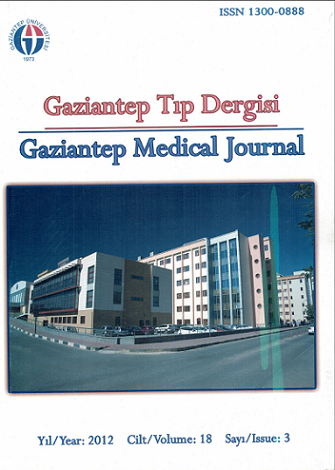Effects of two commercial insulin immunoassays on insulin c-peptide correlation
İki farklı ticari kit ile saptanan insülin düzeylerinin insülin C peptid korelasyonuna etkileri
DOI:
https://doi.org/10.5455/GMJ-30-2012-94Keywords:
Correlation, c-peptide, immunoassay, insulinAbstract
The molar ratio of insulin to C-peptide in peripheral venous blood argues for surreptitious/inadvertent insulin administration or insulinoma/sulfonylurea ingestion as the cause of the hypoglycemia. Commercial immunoassays for insulin are prone to discrepancy because of heterogeneity in circulating forms that react with antisera and cross-reactivity with proinsulin. In this study we compared molar ratio of insulin to C-peptide analyzed by different assays in independent patient groups. In this retrospective study patients admitted to Gaziantep University Hospital Central Laboratory between 2010-2011 recruited the study group. Patients with unknown or positive history of insulin therapy were excluded. Study groups were constructed according to insulin analysis methods; 78 patients whose insulin levels have been assayed by Abbott Architech i2000 (group 1) and by Immulite2000 (n:132, group 2). C peptide levels of the both groups have been analyzed by Immulite2000. Insulin to C-peptide ratio is higher for group1 than group 2 (p>0.05). The correlation coefficient of group 1 was lower than group 2 (r: 0,46 vs. r: 0,65, p<0.001). According to our study insulin C-peptide correlation coefficient was quite low when insulin and C peptide were analyzed with different commercial assays. Although both insulin tests are calibrated against reference preparation, different immunoreactivity of the reagent antibodies to immuncomplexes, heterophile antibodies can lead to such a discrepancy. Results of the study emphasize the importance of standardization for commercial assays insulin assays.
Metrics
References
Lebowitz MR, Blumenthal SA. The molar ratio of insulin to Cpeptide. An aid to the diagnosis of hypoglycemia due to surreptitious (or inadvertent) insulin administration. Arch Intern Med 1993;153(5):650-5.
Cryer PE. Hipoglisemi. In:Braunwald E, Fauci AS, Kasper DL, Hauser DL, Longo DL, Jameson JL, ed. Harrison İç Hastalıkları Prensipleri. 1st ed. Nobel Tıp Kitapevi; 2004:2138-2143.
Van Uytfanghe K, Thienpont LM. Standardization of insulin and C-peptide – A status report Médecine Nucléaire 2010;34 (10):566-570.
Cabaleiro DR, Stöckl D, Kaufman JM, Fiers T, Thienpont LM. Feasibility of Standardization of Serum C-Peptide Immunoassays with Isotope-Dilution Liquid Chromatography– Tandem Mass Spectrometry Clin Chem 2006;52(6):1193-6.
Chen CH, Tsai ST, Chou P. Correlation of fasting serum Cpeptide and insulin with markers of metabolic syndrome-X in a homogeneous Chinese population with normal glucose tolerance. Int J Cardiol 1999;68(2):179-86.
Horwitz DL, Starr JI, Mako ME, Blackard WG, Rubenstein AH Proinsulin, Insulin, and C- Peptide Concentrations in Human Portal and Peripheral Blood J Clin Invest 1975;55(6):1278-83
http://www.westgard.com/rcpa.htm#endocrine (Erişim Tarihi: 28.05.2012).
Martindale RA, Cembrowski GS, Journault LJ, Crawford JL, Tran C, Hofer TL, ve ark. Validating New Reagents: Roadmaps Through the Wilderness. Labmedicine 2006;37(6):347-51.
Palmer IM, Schutte AE, Huisman HW Ethnic and gender differences regarding the insulin-blood pressure relationship. Diabetes Res Clin Pract 2009;85(1):102-10.
Turaa A, Pacini G, Kautzky-Willer A, Gastaldelli A, DeFronzod RA, Ferrannini E, ve ark. Estimation of prehepatic insulin secretion: comparison between standardized C-peptide and insulin kinetic models. Metabolism Clinical and Experimental 2012;61:434- 443.
Downloads
Published
How to Cite
Issue
Section
License
Copyright (c) 2023 European Journal of Therapeutics

This work is licensed under a Creative Commons Attribution-NonCommercial 4.0 International License.
The content of this journal is licensed under a Creative Commons Attribution-NonCommercial 4.0 International License.


















